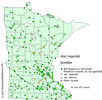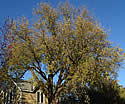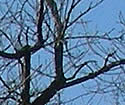Acer negundo (Boxelder)
| Also known as: | Ash-leaf Maple, Manitoba Maple |
|---|---|
| Genus: | Acer |
| Family: | Sapindaceae (Soapberry) |
| Life cycle: | perennial woody |
| Origin: | native |
| Habitat: | part shade, sun; average to moist; river bottoms, lakeshores, windbreaks, woods |
| Bloom season: | April - May |
| Plant height: | 30 to 50 feet |
| Wetland Indicator Status: | GP: FAC MW: FAC NCNE: FAC |
| MN county distribution (click map to enlarge): |  |
| National distribution (click map to enlarge): |  |
Pick an image for a larger view. See the glossary for icon descriptions.
Detailed Information
Flower: 

![[photo of male flowers]](/udata/r9ndp23q/trees/acer-negundo-box-elder_0430_130138-t.jpg) Male and female flowers are on separate trees and appear before or as the leaves emerge in early spring. Male flowers hang in clusters on the outer buds of branches; 3 to 5 stamens at the tip of a slender, hairy stalk, ½ to 1¾ inches long. Immature anthers (stamen tips) are often deep maroon colored.
Male and female flowers are on separate trees and appear before or as the leaves emerge in early spring. Male flowers hang in clusters on the outer buds of branches; 3 to 5 stamens at the tip of a slender, hairy stalk, ½ to 1¾ inches long. Immature anthers (stamen tips) are often deep maroon colored.
![[photo of female flowers]](/udata/r9ndp23q/pd3/acer-negundo-29-t.jpg) Female flowers hang in drooping clusters of 6 to 12 at the tips of branches, each with a long, 2-parted style, and 3 to 5 sepals on a hairy, 1/3-inch stalk.
Female flowers hang in drooping clusters of 6 to 12 at the tips of branches, each with a long, 2-parted style, and 3 to 5 sepals on a hairy, 1/3-inch stalk.
Leaves and bark: 

![[photo of leaves]](/udata/r9ndp23q/trees/acer-negundo-box-elder-front2-t.jpg) Leaves are opposite and compound, typically with 3 to 5 leaflets, occasionally 7. Leaflets are mostly lance-elliptic with an abrupt taper to a pointed tip, up to 3¾ long and 2¼ inches wide, smooth to coarsely toothed around the edges, on stalks that are typically smooth but may be covered in short hairs. The end leaflet is typically largest and often shallowly lobed in 3 parts, sometimes deeply so. Surfaces are mostly smooth, the underside is paler than the upper surface and sometimes sparsely hairy. Leaves turn a dull yellow in fall.
Leaves are opposite and compound, typically with 3 to 5 leaflets, occasionally 7. Leaflets are mostly lance-elliptic with an abrupt taper to a pointed tip, up to 3¾ long and 2¼ inches wide, smooth to coarsely toothed around the edges, on stalks that are typically smooth but may be covered in short hairs. The end leaflet is typically largest and often shallowly lobed in 3 parts, sometimes deeply so. Surfaces are mostly smooth, the underside is paler than the upper surface and sometimes sparsely hairy. Leaves turn a dull yellow in fall.
![[photo of trunk]](/udata/r9ndp23q/pd3/acer-negundo-85309-2-t.jpg) The trunk can be up to 4½ feet in diameter at breast height (dbh), though 3 feet is more typical for a mature tree. Bark is medium to coarse, light brown to gray-brown with blocky, vertical ridges and furrows. Twigs are smooth or densely hairy on newest growth, olive green in summer, more blueish to purple in winter. The crown is irregular, often with low spreading branches wider than the tree height.
The trunk can be up to 4½ feet in diameter at breast height (dbh), though 3 feet is more typical for a mature tree. Bark is medium to coarse, light brown to gray-brown with blocky, vertical ridges and furrows. Twigs are smooth or densely hairy on newest growth, olive green in summer, more blueish to purple in winter. The crown is irregular, often with low spreading branches wider than the tree height.
Fruit: 
![[photo of fruit]](/udata/r9ndp23q/pd3/acer-negundo-15-t.jpg) Fruit is a pair of winged seeds (samara), 1¼ to 2 inches long that matures in late summer, usually persisting on the tree into late winter.
Fruit is a pair of winged seeds (samara), 1¼ to 2 inches long that matures in late summer, usually persisting on the tree into late winter.
Notes:
Boxelder is common and widespread throughout Minnesota, except in the Arrowhead. Minnesotans often do not recognize it as a maple, due to its compound leaves, but in fact, in parts of Canada it goes by the name “Manitoba maple”. It was once quite popular as a farmstead, windbreak and yard tree due to its cold hardiness, drought tolerance and ease in transplanting, It can be a very aggressive colonizer on disturbed sites, as many gardeners have observed from its heavy seed load. The seeds can also attract large numbers of the seed eating boxelder bug. But its wood is soft and brittle, highly disposed to limb breakage and heart rots, even in fairly young trees. Perhaps a tree that can appear to be busy dying the day you plant it? It resprouts readily from stumps and broken limbs and can live to nearly 100 years old. There are 6 recognized varieties, primarily distinguished by branch color, hairiness, and number of leaflets; 2 vars are found in Minnesota: var. negundo, the most common, has hairless twigs and leaf stalks; var. interius has hairy twigs and leaf stalks. The compound leaves may be mistaken for an Ash species, but Ash leaflets are more uniform in shape and never lobed. Early growth has also been mistaken for Poison Ivy (Toxicodendron rydbergii) but the opposite leaves of Boxelder should distinguish it.
Native Plant Nurseries, Restoration and Landscaping Services ↓
More photos
Photos by K. Chayka taken in Ramsey County. Photos courtesy Peter M. Dziuk taken in Anoka and Ramsey counties.
Comments
Have you seen this plant in Minnesota, or have any other comments about it?
on: 2017-07-06 19:22:42
Our 2.5 acres had no trees when we moved into our home. After planting hundreds of trees, and after 8 years, still no shade, except the volunteer Box Elder trees that I have decided to stop mowing and cutting down. Where ever they want to grow, I am letting them alone. In fact, I have stopped mowing an entire acre to achieve a grove of Box Elders. It is surely a maligned species of plant but I am embracing them because of the speed in which they grow and their amazing tenacity.
on: 2018-05-28 15:31:44
I have several volunteers of this tree that I would like to leave alone. (GO CINDY!) ..about 20 feet from the house -- too close in light of brittle wood? My plant/tree expert friend says to get rid of them.
on: 2018-09-16 11:55:48
Found this tree loaded with Boxelder bugs on its trunk at Taylor Park in St. Paul. Many old great native trees in the area.
on: 2019-04-28 21:01:16
You mention that this species is dioecious but I have a tree that for years never produced any seeds. It was the only one on my property and there were no others within miles. Then one year it began to produce seeds. I think the flowers became both staminate and pistillate. There are now small trees popping here and there from this original one. Also, there is another insect that feeds on boxelder: it is the moth Proteoteras crescentana whose larvae bore into the twigs to feed.
on: 2019-05-08 22:30:39
I have been wondering the effect of EAB when it hits. The majority of trees in my woods and in my yard are Ash. Although EAB has not shown effects here yet, I am noticing Boxelders sprouting up in my woods and "garden" this spring. Like CINDY, I'm welcoming this native fast growing tree. I planted 6 pines 2 yrs ago as future Ash replacements, but I think the Boxelders will be good size within a few years.
on: 2023-07-18 12:51:45
We also have several volunteers and are trying to go all native on our 3/4 acre lot. I have topped the tree for a couple of seasons now, mostly because it's under a power line, but it's taking the shape of a broad vase shrub. I'm inclined to keep it if I can maintain it below 15 feet. I'm wondering if anyone else has had success with this. I like the fast growth and staying power and can live with the bugs.
on: 2024-04-17 10:35:52
WOke up this morning to A MASSIVE boxelder plant in my front yard. This put a smile on my face and made my day ! Nothing like a good boxelder plant to put you in a good mood in the morning.







 Boxelder in a residential landscape
Boxelder in a residential landscape fall color
fall color branches
branches twig and buds
twig and buds NOT Poison Ivy!
NOT Poison Ivy!